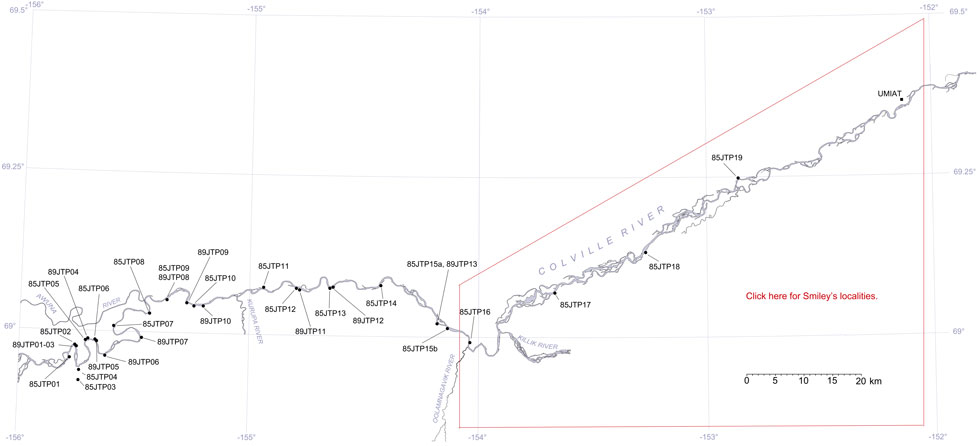Upper Colville River, Alaska
| Map of Northern Alaska | Upper Colville Fossil Images Unassigned | Fossil Images |
|---|
This interactive map of part of the Colville River, Northern Alaska, shows the locations of plant fossil collections made by J.T. Parrish and R.A. Spicer in 1985 and 1989. Click on a number for more details on that site. The red outlined area links to another map showing positions of florules (plant fossil assemblages) collected by C.J. Smiley along both the Colville and Chandler Rivers. |

Locality 89JTP04
Description:
This locality is the same as 85JTP05. Nilssonia and large Ginkgo leaves were found to be common at this site.
A basal sandstone is heavily rooted with abundant plant hash as is an overlying gray/brown claystone with nodular ironstone concretions. The concretions contain abundant branch wood at all angles and not alinged parallel to bedding. These ironstones are just a cemented version of the clays and contain numerous conifer leaf fragments. A sample from the seat earth of a coal contains numerous broad ginkgophyte leaves but they could equally be Podozamites (they are too incomplete to tell). Immediately beneath the seat earth of the coal is a gray brown clay with abundant conifer needles of the Cephatotaxopsis type and a few Equisetites fragments. Ginkgophyte (?) leaves are rare. In a clay within the coal Pityophyllum and "Podozamites?"are abundant. The "Podozamites" leaves could equally be Podozamites or ginkgophyte fragments, preservation is poor. Another clay above the coal is rooted and contains Cephalotaxopsis. Above this is a sandstone with logs and branches and horizons with comminuted plant hash. Sample 89RAS96 was collected from sandstone float at the east end of the section just below a marine transition.
 |
| Aerial photograph of the 'amphitheater' exposure where locality 89JTP04 is situated at the left hand side of the image. |
